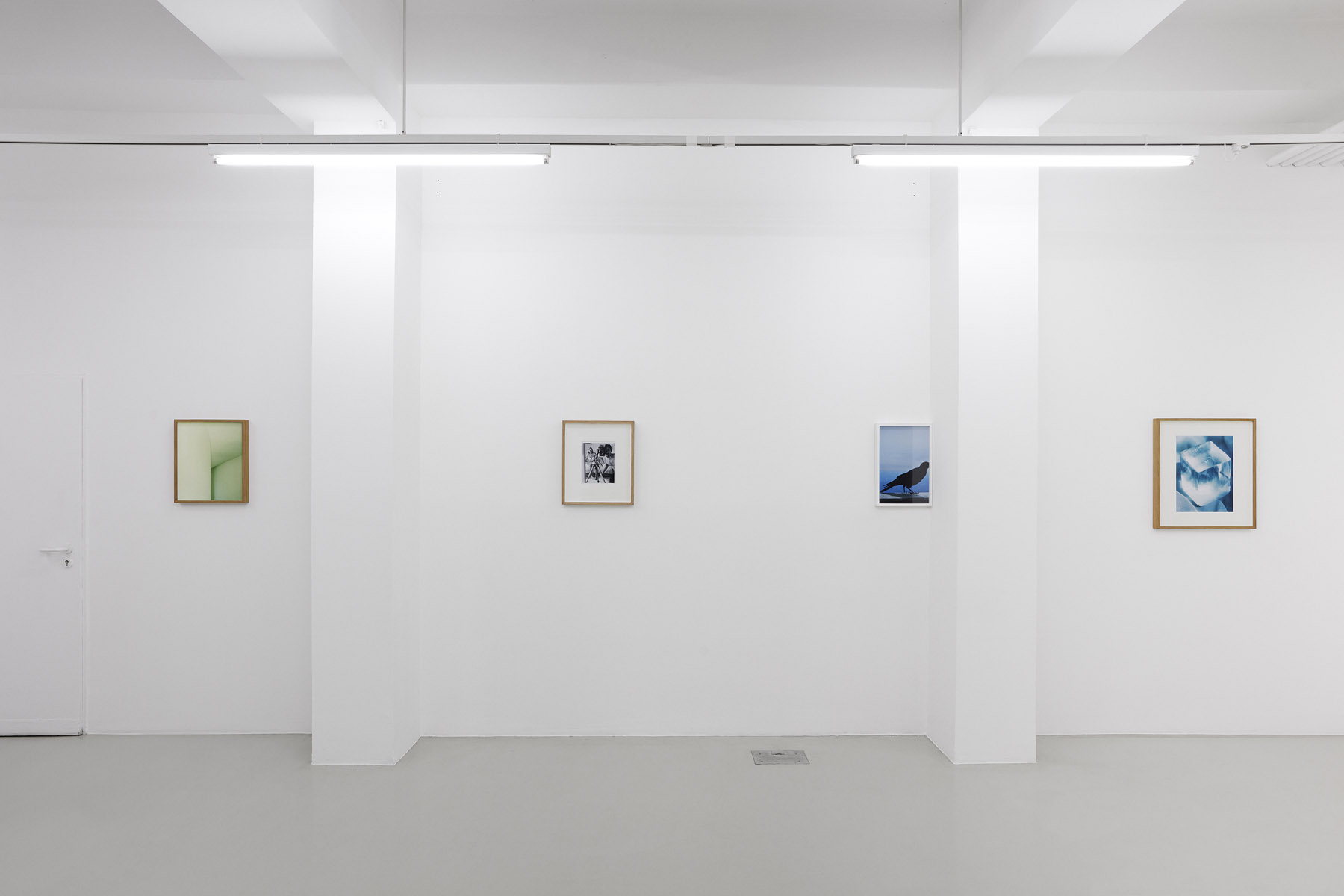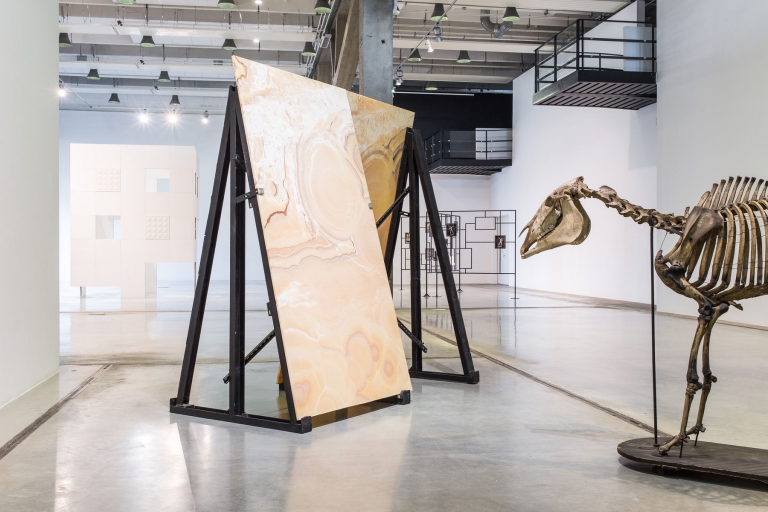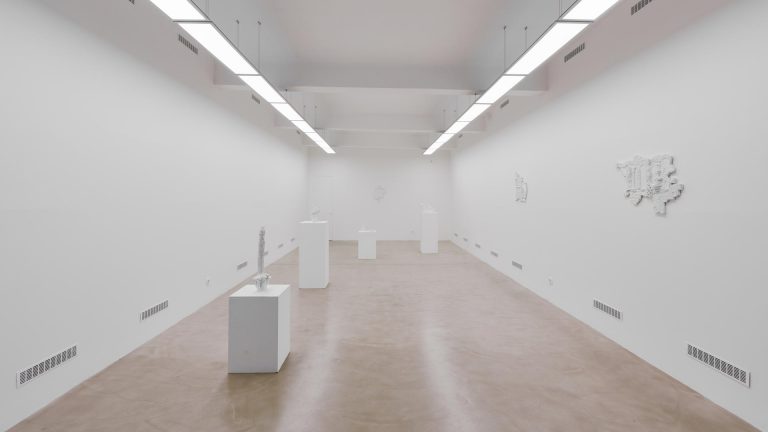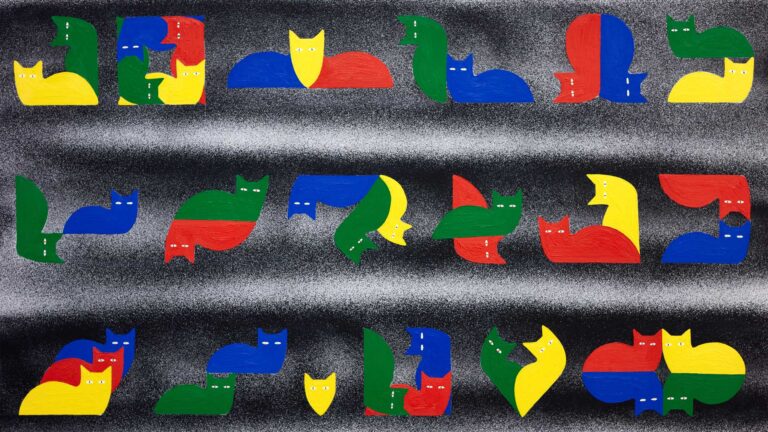Artist: Márton Perlaki
Exhibition title: Soft Corners
Curated by: Borbála Szalai
Venue: Trafó Gallery, Budapest, Hungary
Date: October 31, 2020 – January 21, 2021
Photography: Dávid Biró / all images copyright and courtesy of the artists and Trafó Gallery, Budapest
There are two truly significant moments during the creation of a photograph: the first is when the aperture opens and light enters the photosensitive surface, and the second is when it closes – two tiny and imperceptibly fast events.
But what would happen if instead of opening the aperture by pressing the shutter release, the photographer decided to step back from the camera’s viewfinder and opened the eye that had been closed until then? Two eyes open create a whole new framework that fundamentally reshapes the relationship between the photographer and the image they make, leaving room for a different kind of attention, for the unplanned and uncontrolled processes, for the accidental, the unpredictable, and the uncertain. The full domination over a technical device is replaced by the constant tension brought about by the continuous interplay with the matter; the meticulous editing – by organic manual gestures. The exhibition Soft Corners unfolds this evanescent, yet very dense and defining moment; the moment when Márton Perlaki, leaving the camera behind, establishes a new set of rules for himself as he proceeds from photography towards drawing through the steps of different transfer techniques, and then, his attention turning towards the abstract luminogram and photogram, he finally enters the pitch-black of the darkroom. This time with both eyes open.
The group of works on display at Trafó Gallery started in 2017 as a personal, self-analyzing series mainly containing portraits which dealt with the affective relationships and dynamics within the artist’s family. Although the photos in the exhibition include self-portraits, photos of the artist’s mother, and images visually evoking various non-verbal psychological tests, and therapeutic tools from the artist’s childhood, Perlaki’s attitude is characterized by the duality of opting for these personal issues and consciously keeping quite a distance from them. His images, though strictly constructed, are still playful. He boldly selects and cuts off anything he deems unnecessary, easily bringing details of all sorts of meanings and significance to a common denominator and effortlessly inverting things by turning the positive into the negative, or dissociating what is emotionally too close. Examples of the latter are the large- scale charcoal drawings that began with the enlarging of Perlaki’s 2001 portrait photographs of his father and mother upon each other. Perlaki originally wanted to transfer the lines of the faces with the rather brittle blueprint technique that is used for copying technical drawings. Although the final piece was not created with this technique, its internal logic is still immanent in the drawings. The double portrait, superimposed on a base evoking the characteristic blue hue of the blueprint, underwent several transfers and copies, and the blue turned into its negative khaki color. Then further copies were made until the point when the unplanned subtleties, faults, charcoal smears and the uncertainties of the strokes started to take over the rule of accuracy.
Compared to Márton Perlaki’s previous photographs characterized by the duality of a peculiar, playfully bizarre attitude, and a meticulously preplanned precise editing process, these drawings mark an important step towards a practice, in which spontaneous artistic decisions, mistakes and gesture-like movements are also given space. Later these unpredictable little details and nuances became the protagonists of the images in the case of the photograms and luminograms. Since in a color darkroom one can only act in complete darkness, the work must be also very carefully prepared, paying attention to the smallest details, the finest gradients, and the arc of the movements drawn with light. Unlike in drawing, the result of the movements remains invisible during the process, it is only after the development of the image that it will appear before the eyes, and there- fore no matter how strictly one follows a process, a unique image will be created that differs from the original plan. In the pitch-dark of the darkroom, a tight and rigid framework is in place but it does not paralyze the artist, on the contrary, it opens up so he can lose himself in it. This is a framework that does not aim for capturing reality (or an image of reality), but, if only for a twinkling of an eye, it constructs an autonomous reality of its own from colored lights. And although it seems to move away both from the original personal issues of the series and from the field of photography, somehow it brings us closer to just that.
Márton Perlaki (1982) graduated as a photojournalist at the Bálint György Academy of Journalism and then as a cinematographer at the Hungarian University of Theatre and Film Arts. He was the founder and image editor of The Room magazine. He was nominated for the internationally acclaimed photography prize, the Foam Paul Huf Award initiated by Foam Fotografiemuseum Amsterdam, and in 2015 Perlaki was also invited to the Foam Talent Program. In the same year, one of his works was exhibited at National Portrait Gallery, London in the frameworks of the exhibition of Taylor Wessing Portrait Prize. His work appeared in renowned magazines including Time Magazine, Vogue, New York Magazine, M le Monde or Süddeutsche Zeitung. The last time his works were presented in Budapest was in the frameworks of his solo exhibition at the Robert Capa Contemporary Photography Center in 2016.
Márton Perlaki, Soft Corners, 2020, exhibition view, Trafó Gallery, Budapest, photo: Dávid Biró
Márton Perlaki, Soft Corners, 2020, exhibition view, Trafó Gallery, Budapest, photo: Dávid Biró
Márton Perlaki, Soft Corners, 2020, exhibition view, Trafó Gallery, Budapest, photo: Dávid Biró
Márton Perlaki, Soft Corners, 2020, exhibition view, Trafó Gallery, Budapest, photo: Dávid Biró
Márton Perlaki, Soft Corners, 2020, exhibition view, Trafó Gallery, Budapest, photo: Dávid Biró
Márton Perlaki, Soft Corners, 2020, exhibition view, Trafó Gallery, Budapest, photo: Dávid Biró
Márton Perlaki: Black bird, blue mountains, 2011. | giclee print on fibre based paper, 32,38×47 cm | photo: Dávid Biró
Márton Perlaki: The accident, 2018. | giclee print on fibre based paper, 84,65×73 cm | photo: Dávid Biró
Márton Perlaki: Red pen-Blue paper nr1., 2018. | C-type print, 130×163 cm | photo: Dávid Biró
Márton Perlaki: Ice Cube (blue), 2018. | giclee print on fibre based paper, 59×64,2 cm | photo: Dávid Biró
Márton Perlaki: Left Hand (Mother), 2018. | giclee print on fibre based paper, 73×64,2cm | photo: Dávid Biró
Márton Perlaki, Soft Corners, 2020, exhibition view, Trafó Gallery, Budapest, photo: Dávid Biró
Márton Perlaki, Soft Corners, 2020, exhibition view, Trafó Gallery, Budapest, photo: Dávid Biró
Márton Perlaki, Soft Corners, 2020, exhibition view, Trafó Gallery, Budapest, photo: Dávid Biró
Márton Perlaki, Soft Corners, 2020, exhibition view, Trafó Gallery, Budapest, photo: Dávid Biró
Márton Perlaki: Parents (black), 2020. | acrylic paint and charcoal pencil on paper, 132×162,3 cm | photo: Dávid Biró
Márton Perlaki: Parents (blue), 2018. | acrylic paint and charcoal pencil on paper, 131×163 cm | photo: Dávid Biró
Márton Perlaki: Exhibition view | In the front: Parents (khaki), 2019.|acrylic paint and charcoal pencil on paper, 132×162,8 cm | photo: Dávid Biró
Márton Perlaki: Own constellation nr2., 2019. | C-type print, 130×163 cm photo: Dávid Biró

























